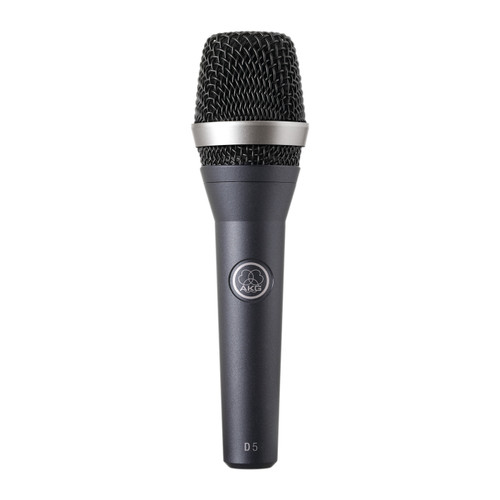The AKG D5 vocal supercardioid dynamic microphone is built to deliver powerful sound for lead and backing vocals even on the noisiest stages. With the D5, the audience is sure to hear the pristine sound of your vocals.
Supercardioid polar pattern in the D5 ensures a tight focus on your voice, keeping out other stage and crowd sounds that you don’t want to be amplified. The supercardioid polar pattern is also frequency-independent, which ensures maximum gain before feedback.
With the D5, you’ll get a crisp sound that cuts through every mix. This is due to several design elements of the microphone, such as the polar pattern and a dual shock mount. An included dual shock mount eliminates microphone handling noise and mechanical noise for high-quality performance in live applications.
AKG D5 Features
- Patented laminated Varimotion diaphragm: For crip sound that cuts through every mix
- High feedback suppression with supercardioid polar pattern: For trouble-free use with on stage monitoring
- Dual shock mount of microphone capsule: Eliminates any kind of handling noise
- Integrated pop filter: For elimination of pops and wind noise
- D5 Dynamic Microphone1
- SA61 Stand Adaptor1
- Microphone Bag1
- Transducer TypeDynamic
- Polar PatternSupercardioid
- Frequency Response70 Hz - 20 kHz
- Output Impedance600 ohms
- Sensitivity2.6 mV/Pa
- Max SPL147 / 156 dB SPL (for 1% / 3% THD)
- Connector 3-pin XLRm
- Dimensions
- Height: 185mm
- Diameter: 51mm
- Net Weight: 320 g
About Dynamic Microphones at Sound Productions
If you’re looking for an all-purpose, heavy-duty microphone, look no further than a dynamic microphone. Equally outstanding in both the studio and live on stage, dynamic mics are an affordable, versatile, and classic option for nearly every miking application. Popular uses include live performances, studio recordings, man-on-the-street style interviews, as well as podcasts that aim for a professional “radio voice” polish.
Dynamic microphones work using a coil attached to a magnet. When sound waves cause the coil to vibrate up and down against the magnet, an electromagnetic current is induced; in simple terms, this turns the sound into an electronic signal to be channeled into a recorded version or—in the case of live sound—into a speaker to distribute the sound to the audience.
























